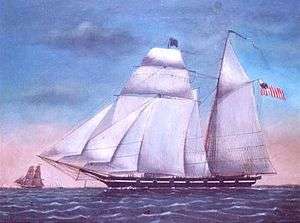Morris-Taney-class cutter
 A Morris-Taney class revenue cutter | |
| Class overview | |
|---|---|
| Builders: | Webb & Allen, New York City |
| Operators: | United States Revenue Cutter Service |
| Built: | 1830–1833 |
| In service: | 1830–1865 |
| Completed: | 13 |
| Lost: | 2 |
| General characteristics | |
| Type: | Revenue cutter |
| Displacement: | 112 tons |
| Length: | 78 ft (24 m) |
| Beam: | 21 ft 3 in (6.48 m) |
| Draft: | 7 ft 8 in (2.34 m) |
| Sail plan: | Topsail Schooner |
| Complement: | 20-24 |
| Armament: | Typically 4 × 6 or 9-pounder guns |
The Morris-Taney class Revenue Cutters were 13 cutters built at New York City at the Webb and Allen shipyard between 1830–1833. These cutters were the backbone of the Service for more than a decade. Samuel Humphreys designed these cutters for roles as diverse as fighting pirates, privateers, combating smugglers and operating with naval forces. He designed the vessels on a naval schooner concept. They had Baltimore Clipper lines. The vessels, built by Webb and Allen, were designed by Isaac Webb and resembled Humphreys' design but had one less port.[1]
Ships
| Name | Commissioned | Decommissioned | Notes |
|---|---|---|---|
| Crawford | 1830 | 1835 | Sold. |
| Dexter | 1830 | 1841 | Sold. |
| Gallatin | 1830 | 1849 | Transferred to the Coast Survey. |
| Hamilton | 1830 | 1853 | Lost in a gale, 1853. |
| Morris | 1831 | 1846 | Sold. |
| Rush | 1831 | 1840 | Transferred to the Lighthouse Service. Sold, 1848. |
| Wolcott | 1831 | 1846 | Transferred to the Lighthouse Service, 1849. Sold, 1851. |
| Ingham | 1832 | 1836 | Sold to the Republic of Texas. |
| Jackson | 1832 | 1865 | Sold. |
| McLane | 1832 | 1840 | Sold. |
| Jefferson | 1833 | 1847 | Renamed Crawford, 1839. Wrecked, 1847. |
| Taney | 1834 | 1858 | Sold. |
| Washington | 1833 | 1837 | Sold. |
References
- ↑ "U.S. Coast Guard Cutter History". uscg.mil. 2012. Retrieved 2 July 2012.
This article is issued from Wikipedia - version of the 3/9/2013. The text is available under the Creative Commons Attribution/Share Alike but additional terms may apply for the media files.